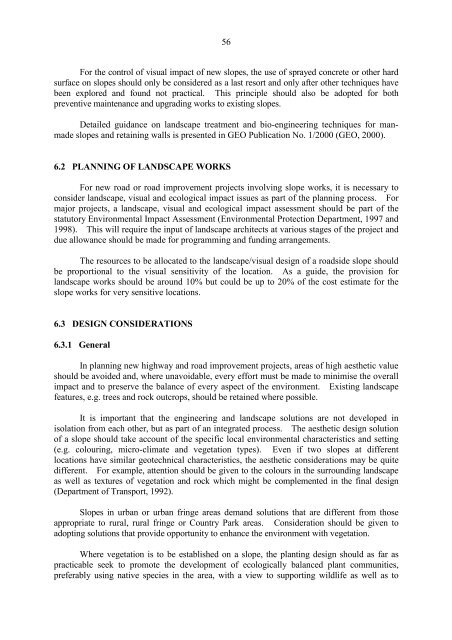Highway Slope Manual
Highway Slope Manual
Highway Slope Manual
You also want an ePaper? Increase the reach of your titles
YUMPU automatically turns print PDFs into web optimized ePapers that Google loves.
56<br />
For the control of visual impact of new slopes, the use of sprayed concrete or other hard<br />
surface on slopes should only be considered as a last resort and only after other techniques have<br />
been explored and found not practical. This principle should also be adopted for both<br />
preventive maintenance and upgrading works to existing slopes.<br />
Detailed guidance on landscape treatment and bio-engineering techniques for manmade<br />
slopes and retaining walls is presented in GEO Publication No. 1/2000 (GEO, 2000).<br />
6.2 PLANNING OF LANDSCAPE WORKS<br />
For new road or road improvement projects involving slope works, it is necessary to<br />
consider landscape, visual and ecological impact issues as part of the planning process. For<br />
major projects, a landscape, visual and ecological impact assessment should be part of the<br />
statutory Environmental Impact Assessment (Environmental Protection Department, 1997 and<br />
1998). This will require the input of landscape architects at various stages of the project and<br />
due allowance should be made for programming and funding arrangements.<br />
The resources to be allocated to the landscape/visual design of a roadside slope should<br />
be proportional to the visual sensitivity of the location. As a guide, the provision for<br />
landscape works should be around 10% but could be up to 20% of the cost estimate for the<br />
slope works for very sensitive locations.<br />
6.3 DESIGN CONSIDERATIONS<br />
6.3.1 General<br />
In planning new highway and road improvement projects, areas of high aesthetic value<br />
should be avoided and, where unavoidable, every effort must be made to minimise the overall<br />
impact and to preserve the balance of every aspect of the environment. Existing landscape<br />
features, e.g. trees and rock outcrops, should be retained where possible.<br />
It is important that the engineering and landscape solutions are not developed in<br />
isolation from each other, but as part of an integrated process. The aesthetic design solution<br />
of a slope should take account of the specific local environmental characteristics and setting<br />
(e.g. colouring, micro-climate and vegetation types). Even if two slopes at different<br />
locations have similar geotechnical characteristics, the aesthetic considerations may be quite<br />
different. For example, attention should be given to the colours in the surrounding landscape<br />
as well as textures of vegetation and rock which might be complemented in the final design<br />
(Department of Transport, 1992).<br />
<strong>Slope</strong>s in urban or urban fringe areas demand solutions that are different from those<br />
appropriate to rural, rural fringe or Country Park areas. Consideration should be given to<br />
adopting solutions that provide opportunity to enhance the environment with vegetation.<br />
Where vegetation is to be established on a slope, the planting design should as far as<br />
practicable seek to promote the development of ecologically balanced plant communities,<br />
preferably using native species in the area, with a view to supporting wildlife as well as to

















